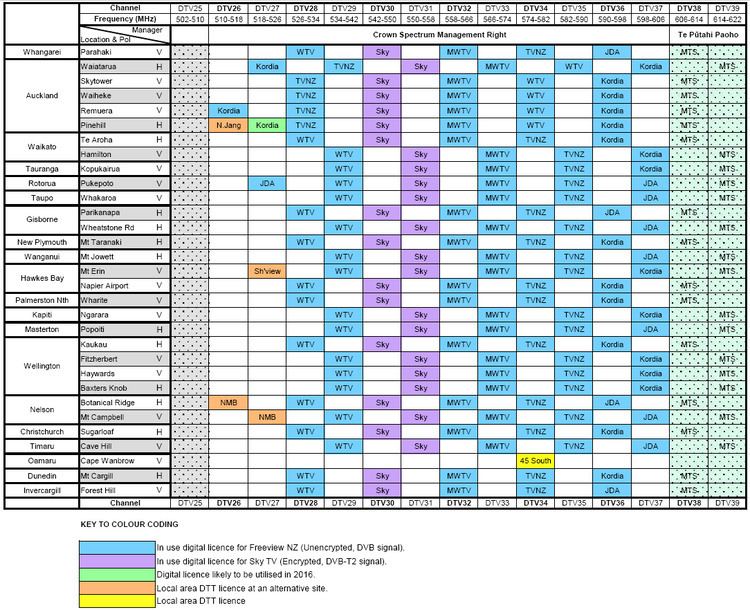 | ||
Channel 37 is a purposefully unused television channel in countries using the M and N broadcast television system standards. The frequency region set aside for Radio Astronomy is really from 600 MHz (0.5m) to 620 MHz (0.4835m) -- but the area reserved or unused differs from nation to nation and region to region (as for example the EU and British Isles have slightly different reserved frequency areas).
Contents
- Allocation issues
- Fictional usage
- In NTSC M countries
- In other countries
- Global UHF TV allocation table 605615 MHz
- National arrangements for radio astronomy different from ITU R
- Legal note
- References
Channel 37 in System M & N countries specifically occupies a band of UHF frequencies from 608 to 614 MHz. This band is particularly important to radio astronomy because it allows observation in a region of the spectrum in between the dedicated frequency allocations near 410 MHz and 1.4 GHz.
One radio astronomy application in this band is for very-long-baseline interferometry.
In 1963, when there were very few stations in the UHF band, the US Federal Communications Commission (FCC) adopted a 10-year moratorium on any allocation of stations to Channel 37. A new ban on such stations took effect at the beginning of 1974, and was made permanent by a number of later FCC actions. As a result of this, and similar actions by the Canadian Radio-television and Telecommunications Commission, Channel 37 has never been used by any over-the-air television station in Canada or the United States.
Some nations, for whatever reason may not only fail to set aside this region for Radio Astronomy -- but may outright allot broadcasters channels in this spectrum region. In New Zealand (as of 2016), Maori Television has been given 2 channel allotments nationwide in this frequency region.
Allocation issues
Reservations and use outside the US have a non-exclusive legal status
Since July 2000, Channel 37 may also be used in the US for medical telemetry equipment on a co-primary basis. This equipment must emit no more than one watt of effective radiated power, and is for use in hospitals and other such facilities.
Channel 1 was also removed from the TV bandplan in the late 1940s, channels 70 to 83 by the 1980s mainly for AMPS mobile phones and, in June 2009, channels 52 to 69 for mobile phones, emergency services and mobile TV services such as Qualcomm's MediaFLO (channel 55). Certain channels, 14 through 20, are used for land mobile communications in some large metropolitan areas in the U.S.
The channels displayed by cable converter boxes under these numbers are not on the same frequencies as their over-the-air counterparts; there are also virtual channel numbering schemes in use in digital television which do not map directly to fixed frequency channel assignments. As such, a "cable 37" channel may (and most often does) exist, but on a much lower frequency.
Fictional usage
Channel 37 is sometimes seen in fiction, the same way telephone numbers with the "555" telephone exchange prefix are used.
Channel 37 has been used as a hypothetical example in instruction manuals, where it serves a role analogous to the fictitious example.org and example.net Internet domains and the 2001:db8 IP address. The "Channel 37" newsroom also occasionally has made a fictional appearance on sites such as YouTube and MySpace.
In NTSC-M countries
Outside North America, channel 37 is actively used in these countries where NTSC-M is used:
In other countries
In these other countries, the frequency allocation for these TV channels is different:
Channel 37 is not the same frequency as it is in the countries using the System-M/N standard. At least in the UK, 606–614 MHz is reserved for radio astronomy.
The UK's namesake "Channel 37", while different in frequency, was formerly part of a small group of channels reserved for non-broadcast purposes such as RF modulators in video players. The UK-named 34-37 channel range is no longer reserved in this manner.
In Japan, UHF television channel frequencies are offset by one channel compared to North American channel naming convention. Japan's channel 36 is in use by TV Asahi in some regions.
In the Philippines, Channel 37 was used by UNTV-37 in Metro Manila as Progressive Broadcasting Corporation's analog channel. However, its digital broadcast assignment is on Channel 38.
Global UHF TV allocation table (605–615 MHz)
This Radio Astronomy Allocation is between the following wavelengths:
DVB-T adoption note : The tables above are not accurate for nations that have adopted DVB-T. The frequencies for audio and video are merged with DVB terrestrial television. The new DVB frequencies are rounded off to an even number in MHz as a general rule.
National arrangements for radio astronomy different from ITU-R
National arrangements for radio astronomy different from ITU-R Radio Regulations
Central & Western Europe
Rest of World
—
Legal note
As national (and ITU) frequency allocations can have multiple users (or no users at all) there should be some disambiguation as to what the various kinds of allocation schemes are
